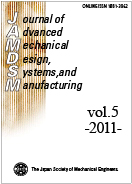5 巻, 4 号
選択された号の論文の15件中1~15を表示しています
- |<
- <
- 1
- >
- >|
Papers
-
2011 年5 巻4 号 p. 227-239
発行日: 2011年
公開日: 2011/10/31
PDF形式でダウンロード (1020K) -
On-machine Measuring and Machining of Freeform Surface Using a Polar-coordinate Desktop Machine Tool2011 年5 巻4 号 p. 240-251
発行日: 2011年
公開日: 2011/10/31
PDF形式でダウンロード (1448K) -
A Method to Derive Friction and Rolling Power Loss Formulae for Mixed Elastohydrodynamic Lubrication2011 年5 巻4 号 p. 252-263
発行日: 2011年
公開日: 2011/11/01
PDF形式でダウンロード (531K) -
2011 年5 巻4 号 p. 264-273
発行日: 2011年
公開日: 2011/11/15
PDF形式でダウンロード (380K) -
2011 年5 巻4 号 p. 274-283
発行日: 2011年
公開日: 2011/11/22
PDF形式でダウンロード (547K) -
2011 年5 巻4 号 p. 284-294
発行日: 2011年
公開日: 2011/11/22
PDF形式でダウンロード (921K)
Technical Note
-
2011 年5 巻4 号 p. 295-301
発行日: 2011年
公開日: 2011/11/25
PDF形式でダウンロード (692K)
Papers
-
2011 年5 巻4 号 p. 302-314
発行日: 2011年
公開日: 2011/11/30
PDF形式でダウンロード (787K) -
2011 年5 巻4 号 p. 315-328
発行日: 2011年
公開日: 2011/11/30
PDF形式でダウンロード (1826K) -
2011 年5 巻4 号 p. 329-346
発行日: 2011年
公開日: 2011/12/08
PDF形式でダウンロード (682K) -
2011 年5 巻4 号 p. 347-357
発行日: 2011年
公開日: 2011/12/08
PDF形式でダウンロード (1712K) -
2011 年5 巻4 号 p. 358-371
発行日: 2011年
公開日: 2011/12/13
PDF形式でダウンロード (2017K) -
2011 年5 巻4 号 p. 372-384
発行日: 2011年
公開日: 2011/12/15
PDF形式でダウンロード (2169K) -
2011 年5 巻4 号 p. 385-394
発行日: 2011年
公開日: 2011/12/15
PDF形式でダウンロード (1029K) -
2011 年5 巻4 号 p. 395-402
発行日: 2011年
公開日: 2011/12/28
PDF形式でダウンロード (864K)
- |<
- <
- 1
- >
- >|
